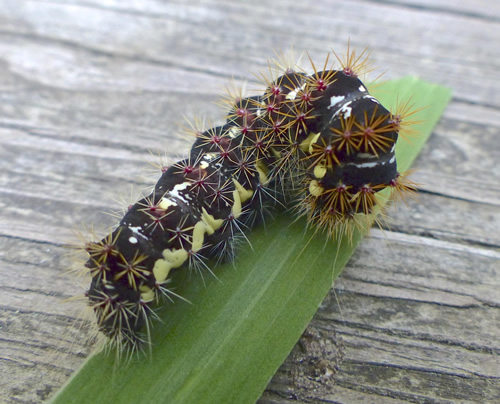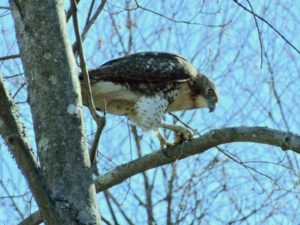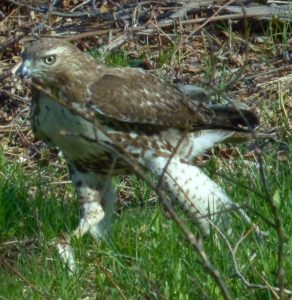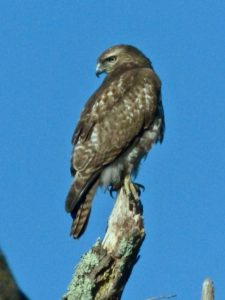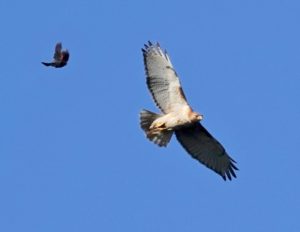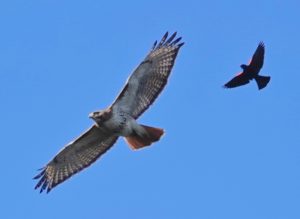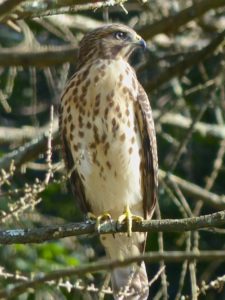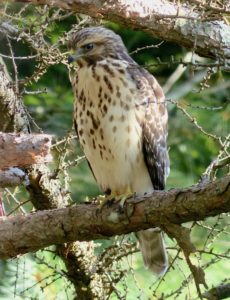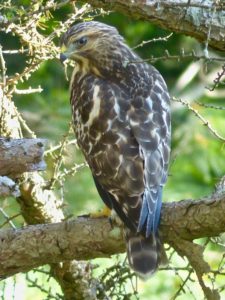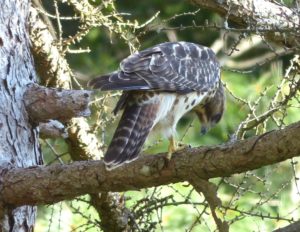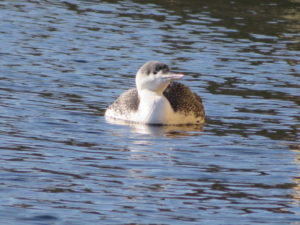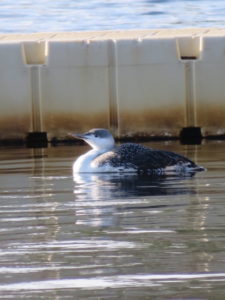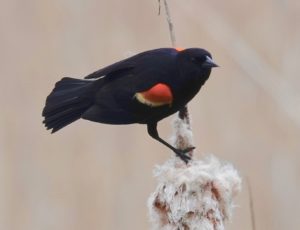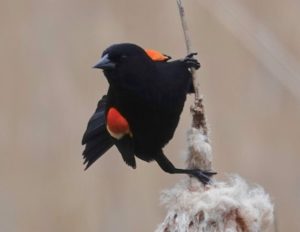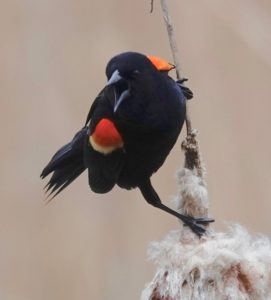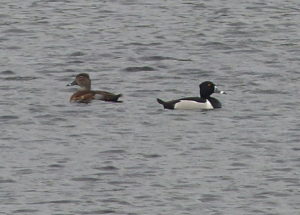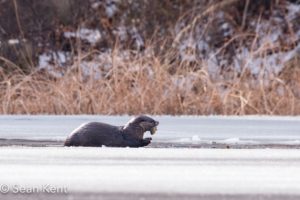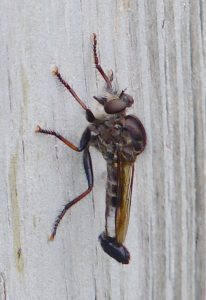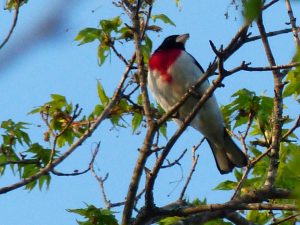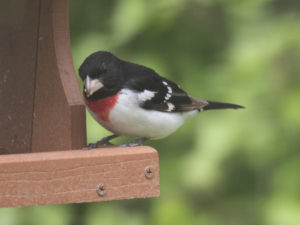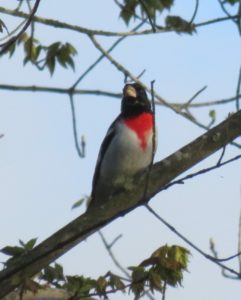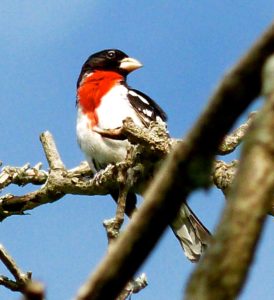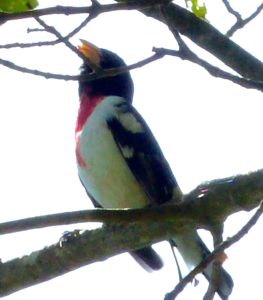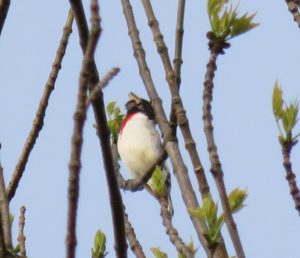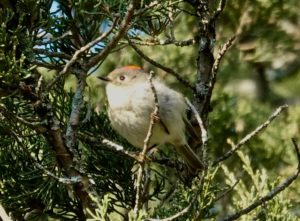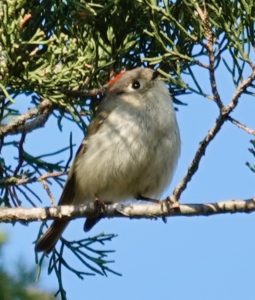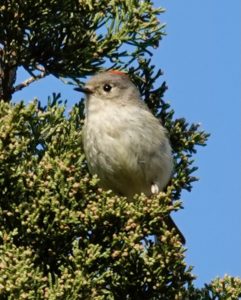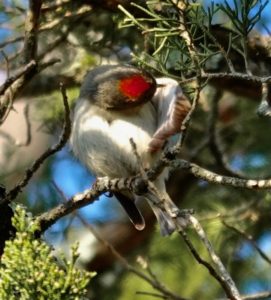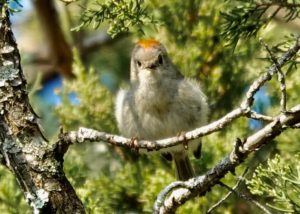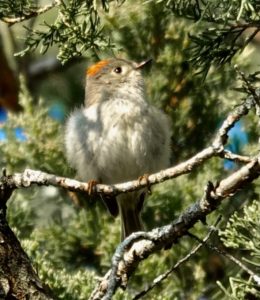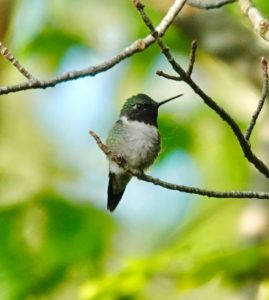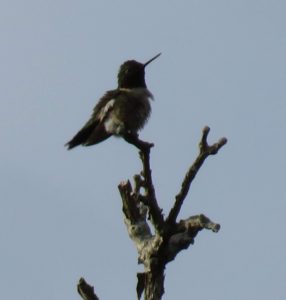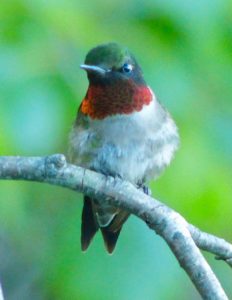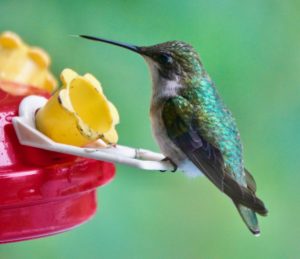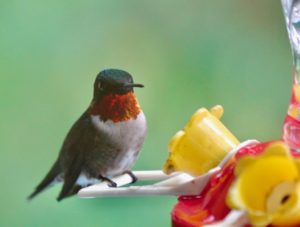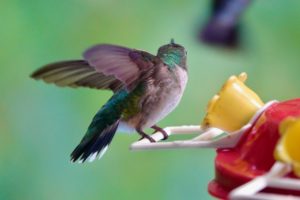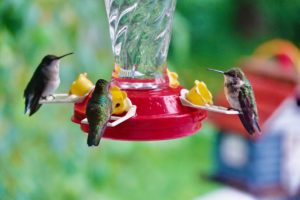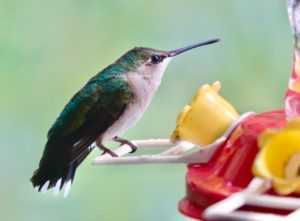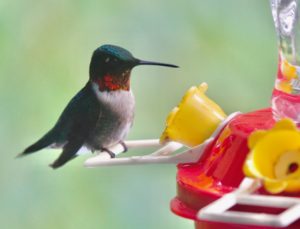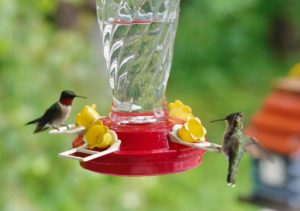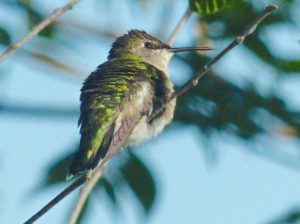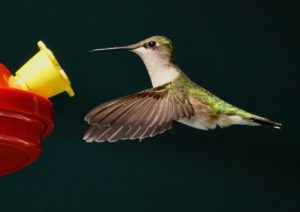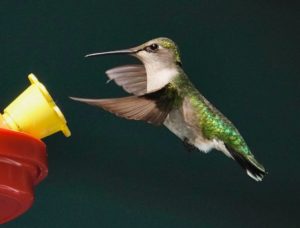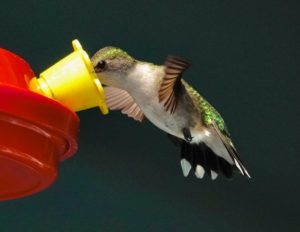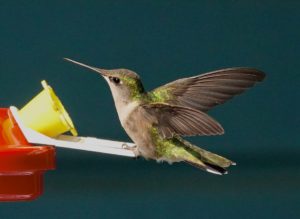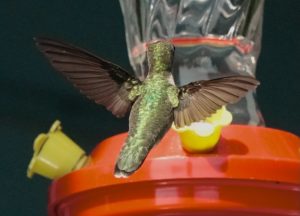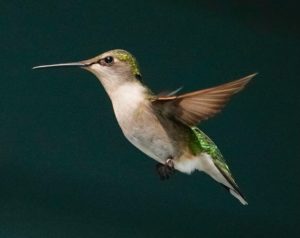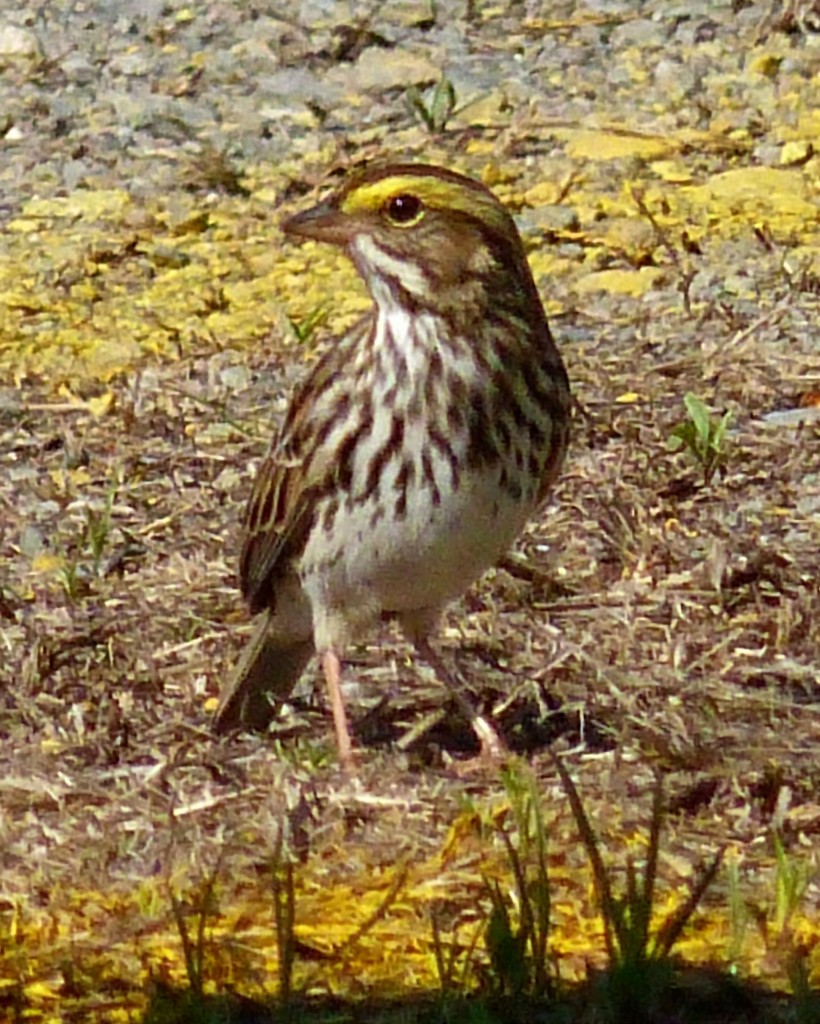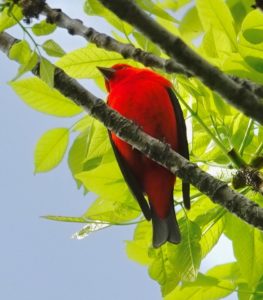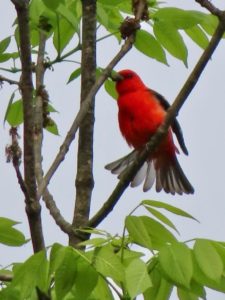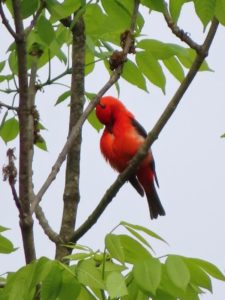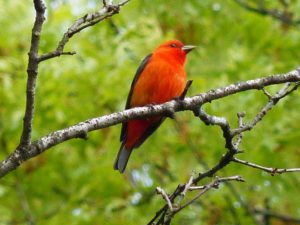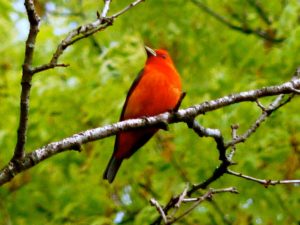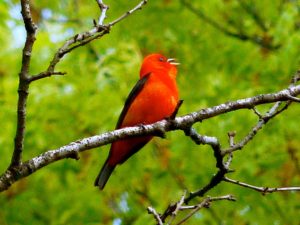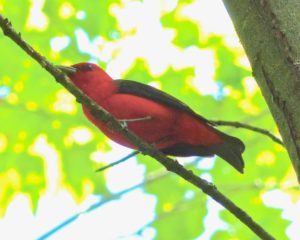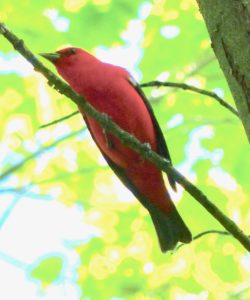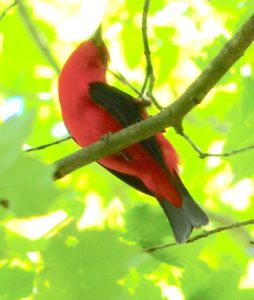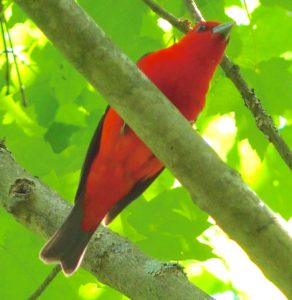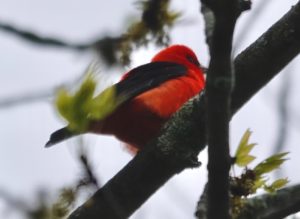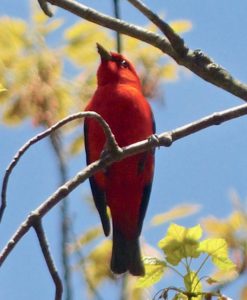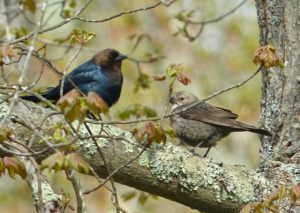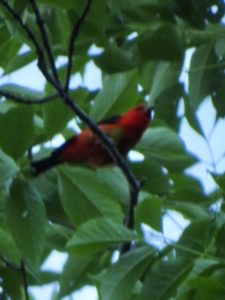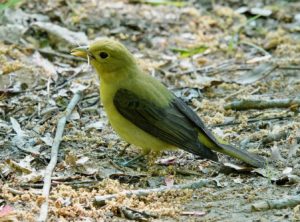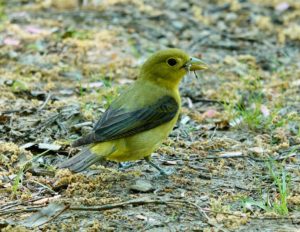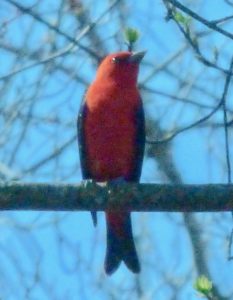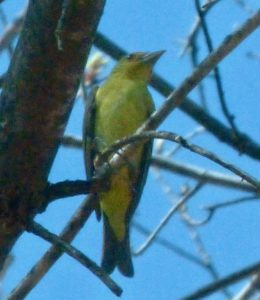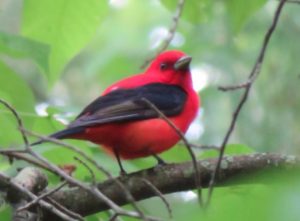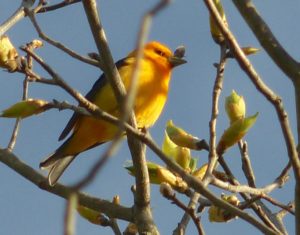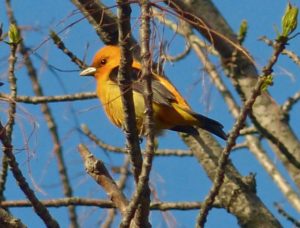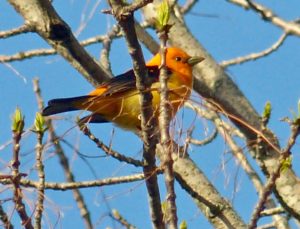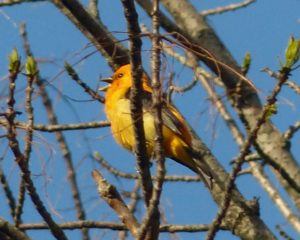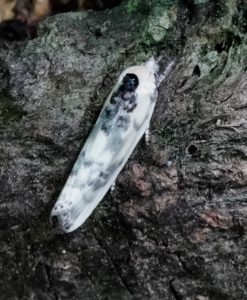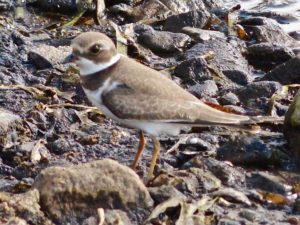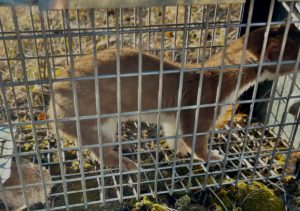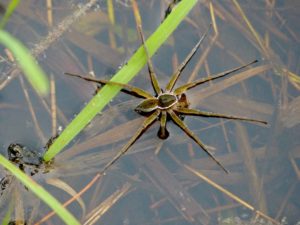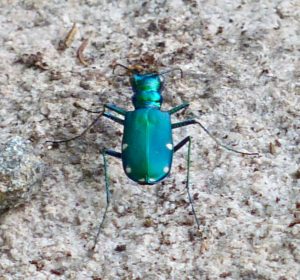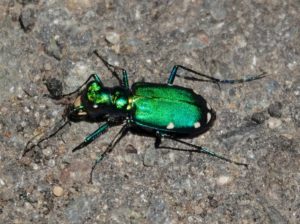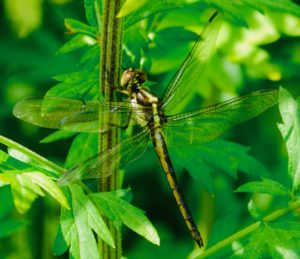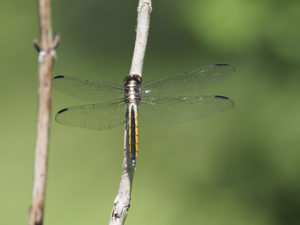Sightings – Animals
Observer: Paul Lauenstein
Observation Date: 5/2/18
Obseration Time: 8:00 a.m.
Observation Location: Moose Hill Audubon Wildlife Sanctuary
Common Name: Red-tailed hawk
Scientific Name: Buteo jamaicensis
Comments: This red-tail had caught something – either a mouse or a frog. The hawk lost its grip on its prey, which dropped to the ground. The hawk immediately swooped down to the ground to retrieve its prize.
More information: All About Birds
Observer: Paul Lauenstein
Observation Date: 5/20/20
Observation Time: 4:26 p.m.
Observation Location: high tension lines opposite Ward’s Berry Farm
Common Name: Red-tailed Hawk
Scientific Name: Buteo jamaicensis
Comments: Red-tailed hawks are often harassed by songbirds. This one was engaged in a dogfight with a redwing blackbird.
More Information: All About Birds
Observer: Paul Lauenstein
Observation Date: 8/14/13
Observation Time: 7:00 a.m.
Observation Location: 4 Gavins Pond Road
Common Name: Red-tailed Hawk (juvenile)
Scientific Name: Buteo jamaicensis
Comments: Red-tails are big, but they only weigh a maximum of about 3 lbs. They can live up to 30 years. They feed predominantly on small mammals.
I took these photos out the kitchen window.
More Information: PBase
Observer: Deborah Radovsky
Observation Date: 12/3/18
Observation time: 9:30 a.m.
Observation Location: Lake Massapoag, swimming very close to shore
Common Name: Red-throated Loon
Scientific Name: Gavia stellata
Comments: Adult, non-breeding plummage. Breeds in the arctic.
More information: Wikipedia
Observer: Paul Lauenstein
Observation Date: 5/18/20
Observation Time: 8:45 a.m.
Observation Location: wetlands under high tension wires across the road from the Gavins Pond soccer fields
Common Name: Red-winged blackbird
Scientific Name: Agelaius phoeniceus
Comments: Red-winged blackbirds are typically found near water. Only the males have bright red epaulets on their wings
More Information: All about Birds
This is a female red-winged blackbird:
Observer: Josh Simons
Observation Date: 5/12/20
Observation Time: 6:00 p.m.
Observation Location: Moose Hill area
Common Name: Red-winged blackbird (female)
Scientific Name: Agelaius phoeniceus
Comments: Red-winged blackbirds are typically found near water. The males are black with bright red epaulets on their wings. The females are dramatically different. The bird in this photo is a female.
More Information: All about Birds
Observer: Paul Lauenstein
Observation Date: 8/11/10
Observation Time: 8:00 a.m.
Observation Location: Gavins Pond outflow pool
Common Name: Redfin Pickerel
Scientific Name: Esox americanus americanus
Comments: Redfin pickerel only reach a maximum of about a foot in length. They are typically much smaller—this specimen was only about 4″ long. They are common in Sharon’s streams. Preys on invertibrates and smaller fish.
More Information: Wikipedia
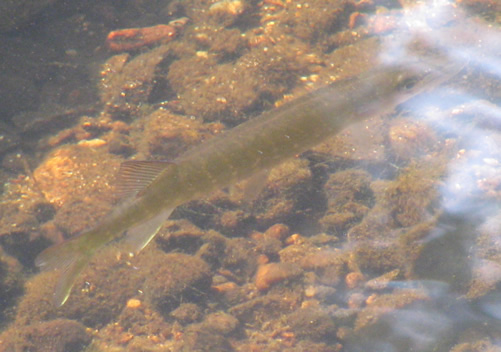
Observer: Paul Lauenstein
Observation Date: 3/1/11
Observation Time: 5:10 p.m.
Observation Location: near Gavins Pond
Common Name: Redwing blackbird
Scientific Name: Agelaius phoeniceus
Comments: First redwing I’ve seen this season. The ground is blanketed in old snow and the pond is still frozen solid. In fall and winter they eat weedy seeds such as ragweed and cocklebur as well as native sunflowers and waste grains.
More Information: All about Birds
Observer: Paul Lauenstein
Observation Date: 5/15/14
Observation Time: 5:10 p.m.
Observation Location: Gavins Pond Road
Common Name: Redwing blackbird
Scientific Name: Agelaius phoeniceus
Comments: Redwing blackbirds are typically found near water.
More Information: All about Birds
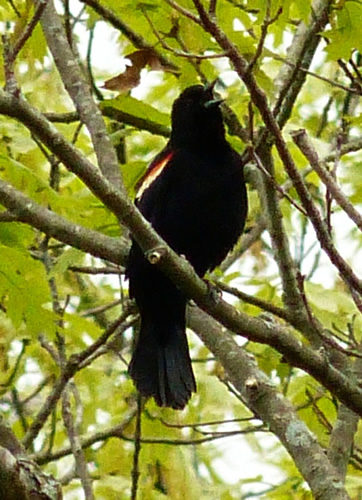
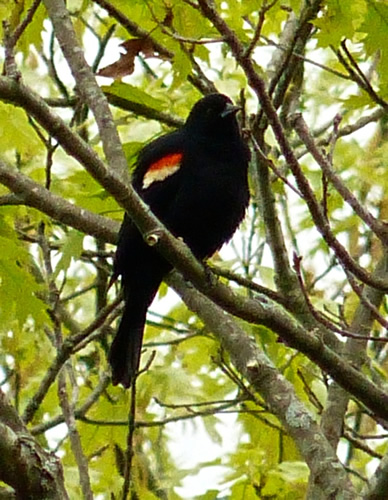
Observer: Paul Lauenstein
Observation Date: 3/19/09
Observation Time: 4:00 p.m.
Observation Location: Gavin’s Pond
Common Name: Ring-necked Duck
Scientific Name: Aythya collaris
Comments: I saw ring-necked ducks last spring at Gavins Pond. They must use Gavins Pond to rest and feed during their migration.
More Information: All About Birds: Ring-necked Duck
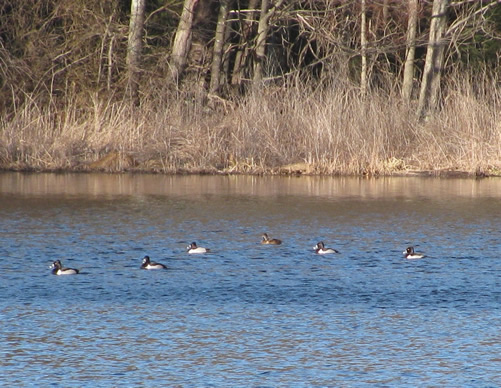
Observer: Paul Lauenstein
Observation Date: 3/25/11
Observation Time: 5:20 p.m.
Observation Location: Gavin’s Pond
Common Name: Ring-necked Duck
Scientific Name: Aythya collaris
Comments: Ring-necked ducks migrate through Sharon, and can be seen in spring and fall.
More Information: All About Birds: Ring-necked Duck
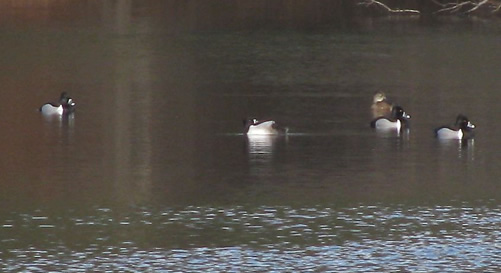
Observer: Paul Lauenstein
Observation Date: 4/18/13
Observation Time: 2:20 p.m.
Observation Location: Gavin’s Pond
Common Name: Ring-necked Duck
Scientific Name: Aythya collaris
Comments: Ring-necked ducks migrate through Sharon, and can be seen in spring and fall.
More Information: All About Birds: Ring-necked Duck
Observer: Pat Gardner
Observation Date: 11/11/12
Observation Time: 6:15 a.m.
Observation Location: Shepard’s Pond, Canton
Common Name: River Otter
Scientific Name: Lontra canadensis
Comments: This morning there was only one, but over the past 2 months there’ve been 2. Shepard’s Pond is on the Canton-Sharon border.
More Information: Massachusetts Division of Fisheries and Wildlife
Observer: Sue Price
Observation Date: 2/15/13
Observation Time: 7:30 a.m.
Observation Location: Bay Road near Wilshire (going from Sharon to Stoughton)
Common Name: River Otter
Scientific Name: Lontra canadensis
Comments: I think it was a river otter. It was very dark with a long fat tail and moved very quickly – don’t think it was a beaver as it had a long thin body.
More Information: Massachusetts Division of Fisheries and Wildlife
Observer: Joe Macri
Observation Date: 3/3/14
Observation Time: 5:30 p.m.
Observation Location: High Plain St. approx. 200 yards from intersection with Norwood St.
Common Name: River Otter
Scientific Name: Lontra canadensis
Comments: Just at sunset, I observed a large, sinuous animal crossing the road. I only saw it briefly and in silhouette, but was surprised by the size of it. When looking online I narrowed it down to River Otter or Fisher Cat. I’m 99% sure it was a River Otter, though.
More Information: National Geographic
Observer: Sean Kent
Observation Date: Week of 2/2/18 to 2/9/18
Observation Location: Trowelshop Pond in Sharon
Common Name: River Otter
Scientific Name: Lontra canadensis
Comments: At the beginning of February, three otters have been quite visible during the day at Trowel Shop Pond in Sharon.
More Information: The Otters of Trowelshop Pond
Observer: Paul Lauenstein
Observation Date: 7/18/15
Observation Time: 5:10 p.m.
Observation Location: Gavins Pond Dam
Common Name: Robber fly (male)
Scientific Name: Efferia apicalis
Comments: Robber flies of the genus Efferia are small to large-sized robber flies (10–40 mm) with a distinctly different shape of the posterior end of the abdomen in males versus females. Females have a short or long ovipositor that is hairless and short conical to slender wedge-shaped, its color is usually glossy black. Males (such as the one pictured below) have a “helicopter tail” with glossy black claspers that are covered in hairs, forming part of a complex genital structure (the combined epandrium and hypandrium) that is clearly larger than the abdominal segments and is oriented diagonally to vertically upwards relative to the main body axis.
As is typical for robber flies, adult Efferia are ambush predators, taking off from a resting position on the ground or on a branch to intercept other flying insects in mid-air.
More Information: Wikipedia
Observer: Paul Lauenstein
Observation Date: 6/4/11
Observation Time: 3:15 p.m.
Observation Location: Conservation land near Billings Street
Common Name: Roland’s Sallow Moth (caterpillar)
Scientific Name: Psaphida rolandi
More Information: Bug Guide
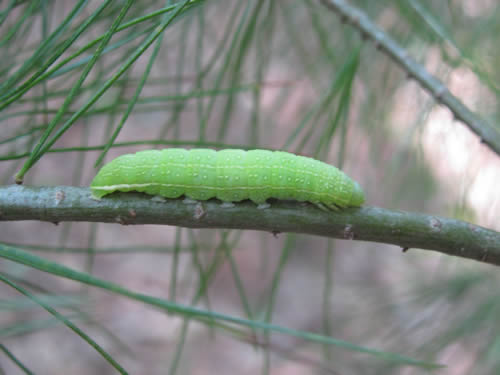
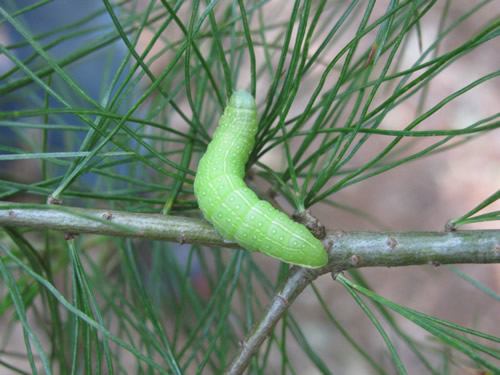
Observer: Paul Lauenstein
Observation Date: 5/12/16
Observation Time: 6:40 a.m.
Observation Location: Moose Hill Audubon Wildlife Center
Common Name: Rose-breasted Grosbeak
Scientific Name: Pheucticus ludovicianus
Comments: Look for these birds in forest edges and woodlands. Listen, too, for their distinctive voices. They sound like American Robins, but listen for an extra sweetness, as if the bird had operatic training; they also make a sharp chink like the squeak of a sneaker.
More Information: All About Birds
Observer: Josh Simons
Observation Date: 5/18/20
Observation Time: 9:00 a.m.
Observation Location: Moose Hill area
Common Name: Rose-breasted Grosbeak
Scientific Name: Pheucticus ludovicianus
Comments: The male rose-breasted grosbeak is one of Sharon’s more photogenic songbirds, especially on a sunny morning. The female is drab brown. Its song has a melodic, flute-like quality. If you listen to a recording of its song and learn to recognize it, you might find one by listening.
More Information: All About Birds
Observer: Deb Radovsky
Observation Date: 5/20/18
Observation Time: N/A
Observation Location: Moose Hill Audubon Wildlife Sanctuary
Common Name: Rose-breated Grosbeak
Scientific Name: Pheucticus ludovicianus
Comments: Look for these birds in forest edges and woodlands. Listen, too, for their distinctive voices. They sound like American Robins, but with an extra sweetness. They also make a sharp chink like the squeak of a sneaker.
More Information: All About Birds
Observer: Paul Lauenstein
Observation Date: 5/23/16
Observation Time: 7:50 a.m.
Observation Location: Moose Hill Audubon Wildlife Sanctuary
Common Name: Rose-breasted Grosbeak
Scientific Name: Pheucticus ludovicianus
Comments: The male rose-breasted grosbeak is one of our more photogenic songbirds, especially on a sunny morning. The female is drab brown.
More Information: All About Birds
Observer: Paul Lauenstein
Observation Date: 6/2/14
Observation Time: 11:50 a.m.
Observation Location: in the woods near Gavins Pond
Common Name: Rose-breasted Grosbeak
Scientific Name: Pheucticus ludovicianus
Comments: I found this specimen by listening to its call.
More Information: All About Birds
Observer: Josh Simons
Observation Date: 6/25/11
Observation Time: 1:00 p.m.
Observation Location: Moose Hill area
Common Name: Rose-breasted Grosbeak
Scientific Name: Pheucticus ludovicianus
Comments: A female just after a bath.
More Information: All About Birds
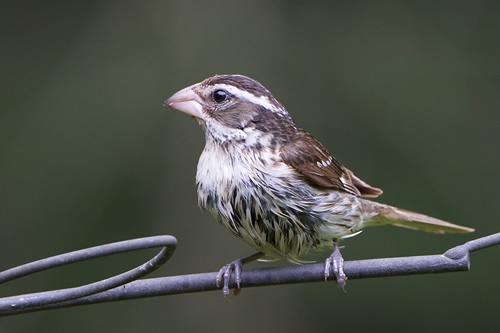
Observer: Deb Radovsky
Observation Date: 5/18/2016
Observation TIme: N/A
Observation Location: Moose Hill area
Common Name: Rose-breasted Grosbeak
Scientific Name: Pheucticus ludovicianus
Comments:
More Information: All About Birds
Observer: Josh Simons
Observation Date: 10/31/12
Observation Time: 1:00 p.m.
Observation Location: Wolomolopoag Pond
Common Name: Ross’s Goose
Scientific Name: Chen rossii
Comments: Tight crop, some light dodging and burning to allow black tail to be seen a little better against the background.
More Information: All About Birds
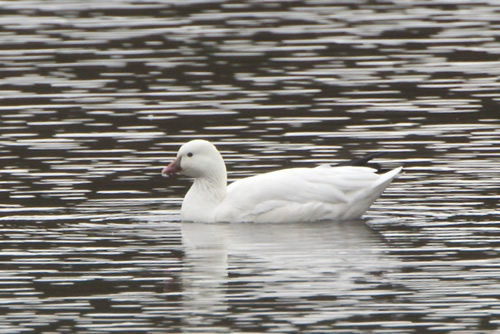
Observer: Paul Lauenstein
Observation Date: 11/12/12
Observation Time: 5:05 p.m.
Observation Location: Wolomolopoag Pond
Common Name: Ross’s Goose
Scientific Name: Chen rossii
Comments: The Ross’s goose resembles a snow goose, but smaller, and with a shorter neck. It is snow white with black wing tips. This individual was seen among dozens of Canada geese on their way south for the winter, and attracted a number of bird watchers to Wolomolopoag Pond.
More Information: All About Birds
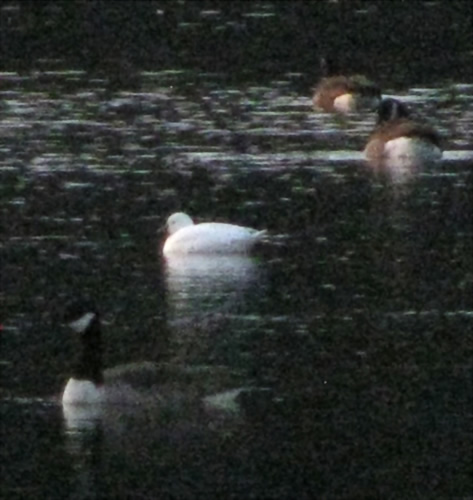
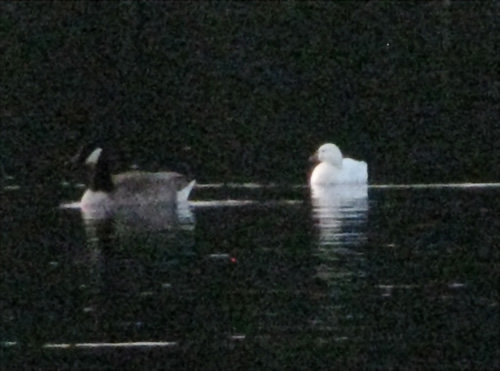

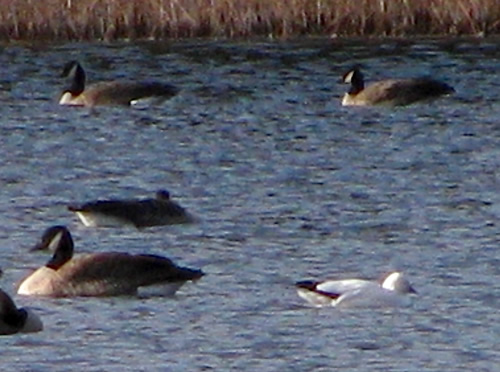
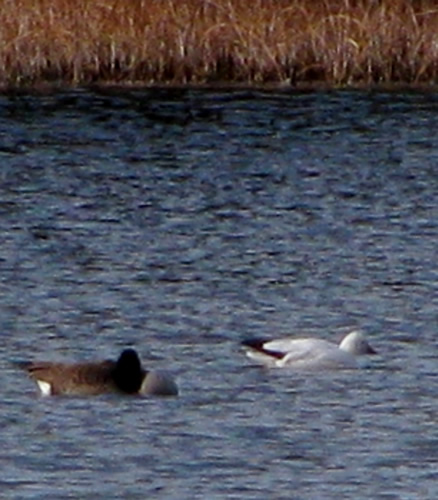
Observer: Paul Lauenstein
Observation Date: 7/26/10
Observation Time: 6:45 a.m.
Observation Location: Gavins Pond Road
Common Name: Ruby Meadowhawk dragonfly
Scientific Name: Sympetrum rubicundulum
More Information: Wikipedia
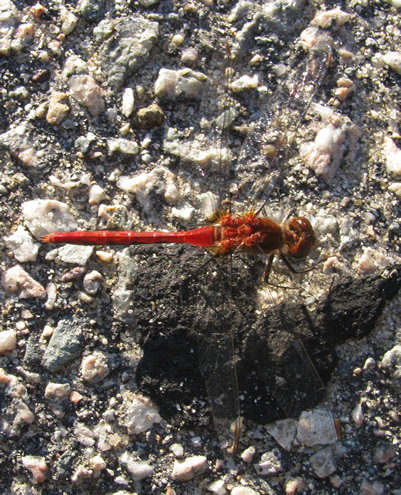
Observer: Paul Lauenstein
Observation Date: 4/27/23
Observation Time: 6:45 am
Observation Location: Moose Hill Audubon Wildlife Sanctuary
Common Name: Ruby-crowned Kinglet
Scientific Name: Corthylio calendula
Comments: Ruby-crowned kinglets are tiny – even smaller than chickadees. They migrate through Sharon in spring en route to nesting areas in northern New England and Canada.
More Information: All About Birds
Observer: Paul Lauenstein
Observation Date: 5/15/23
Observation Time: 6:35 a.m.
Observation Location: Moose Hill Audubon Wildlife Sanctuary
Common Name: Ruby-throated Hummingbird
Scientific Name: Archilochus colubris
Comments: The throat of the hummingbird in the photo looks black, but when it flew I saw a flash of bright crimson.
Ruby-throated hummingbirds are the only species of hummingbird commonly seen in New England. They overwinter in Costa Rica. When they migrate north in spring, they fly several hundred miles across the Gulf of Mexico. They arrive in Massachusetts in late April. That’s a good time to put out a hummingbird feeder. If you’re lucky, and you change the sugar water in the feeder regularly, they’ll nest nearby and visit your feeder all summer.
Hummingbirds make their nests out of lichens and spider webs. They weigh about as much as a nickel.
More Information: All About Birds
Observer: Josh Simons
Observation Date: 5/17/23
Observation Time: 12:30 p.m.
Observation Location: Moose Hill Parkway
Common Name: Ruby-throated Hummingbird
Scientific Name: Archilochus colubris
Comments: The throat of the hummingbird in the photo looks black, but when it catches the sunlight it flashes bright red.
Ruby-throated hummingbirds are the only species of hummingbird commonly seen in New England. They overwinter in Costa Rica. When they migrate north in spring, they fly several hundred miles across the Gulf of Mexico. They arrive in Massachusetts in late April. That’s a good time to put out a hummingbird feeder. If you’re lucky, and you change the sugar water in the feeder regularly, they’ll nest nearby and visit your feeder all summer.
Hummingbirds make their nests out of lichens and spider webs. They weigh about as much as a nickel.
More Information: All About Birds
Observer: Deb Radovsky
Observation Date: 5/18/16
Observation TIme: N/A
Observation Location: Moose Hill area
Common Name: Ruby-throated Hummingbird
Scientific Name: Archilochus colubris
Comments: Ruby-throated hummingbirds are the only species of hummingbird commonly seen in New England. They overwinter in Costa Rica, and arrive in Massachusetts around May 1 every year. That’s a good time to put out a hummingbird feeder. If you’re lucky, and you change the sugar water in the feeder regularly, they’ll nest nearby and visit your feeder all summer.
More Information: All About Birds
Observer: Paul Lauenstein
Observation Date: 6/16/14
Observation Time: 6:45 p.m.
Observation Location: 4 Gavins Pond Rd.
Common Name: Ruby-throated Hummingbird
Scientific Name: Archilochus colubris
Comments: Ruby-throated hummingbirds migrate all the way from New England to Central America and back every year – a journey of about 2,500 miles including 500 miles over the Gulf of Mexico. They can live up to 10 years, so they log a lot of miles for a creature that weighs less than a dime.
More Information: All About Birds
Observer: Josh Simons
Observation Date: 6/25/11
Observation Time: 1:00 p.m.
Observation Location: Moose Hill area
Common Name: Ruby-throated Hummingbird
Scientific Name: Archilochus colubris
Comments: Female (sticking out her long tongue, which is adapted to probing for nectar in flower blossoms)
More Information: All About Birds
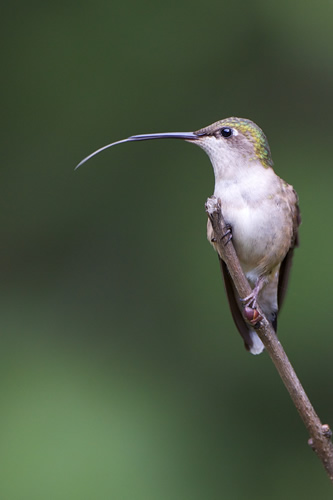
Observer: Paul Lauenstein
Observation Date: 7/3/21
Observation Time: 2:00 p.m.
Observation Location: 4 Gavins Pond Rd.
Common Name: Ruby-throated Hummingbird
Scientific Name: Archilochus colubris
Comments: Ruby-throated hummingbirds are the only species of hummingbird commonly seen in New England. They overwinter in Costa Rica. When they migrate north in spring, they fly several hundred miles across the Gulf of Mexico. They arrive in Massachusetts in late April. That’s a good time to put out a hummingbird feeder. If you’re lucky, and you change the sugar water in the feeder regularly, they’ll nest nearby and visit your feeder all summer. They make their nests out of lichens and spider webs. They weigh about as much as a nickel.
More Information: All About Birds
Observer: Paul Lauenstein
Observation Date: 5/21/16
Observation Time: 7:10 a.m.
Observation Location: Moose Hill Farm (The Trustees of Reservations)
Common Name: Ruby-throated Hummingbird
Scientific Name: Archilochus colubris
Comments: Ruby-throated hummingbirds are the only species of hummingbird commonly seen in New England. They overwinter in Costa Rica, and arrive in Massachusetts around May 1 every year. That’s a good time to put out a hummingbird feeder. If you’re lucky, and you change the sugar water in the feeder regularly, they’ll nest nearby and visit your feeder all summer.
More Information: All About Birds
Observer: Paul Lauenstein
Observation Date: 6/11/23
Observation Time: 9:40 a.m.
Observation Location: Gavins Pond Rd.
Common Name: Ruby-throated Hummingbird (female)
Scientific Name: Archilochus colubris
Comments: Our hummingbird feeder, located right outside our kitchen window, provides close-up views of these fascinating creatures from late April through mid-September. All we have to do is clean the feeder and change the sugar water (1/4 cup of sugar per cup of water) every four or five days.
With a little patience, hummingbirds can even be trained to feed from your hand using a small hand-held feeder.
If hummingbirds find the feeder when they arrive in spring, they’ll nest nearby, weaving their teacup-size nests from lichens and spider webs. Their two white eggs are the size of jelly beans.
Ruby-throated hummingbirds are the only species of hummingbird commonly seen in New England. They overwinter in Costa Rica. When they migrate north in spring, they fly several hundred miles across the Gulf of Mexico.
Hummingbirds make their nests out of lichens and spider webs. They weigh about as much as a nickel.
These photos were taken on a sunny morning with a shutter speed of 1/5,000th of a second.
More Information: All About Birds
Observer: Josh Simons
Observation Date: 1/1/14
Observation Time: 4:42 p.m.
Observation Location: Moose Hill Audubon Wildlife Sanctuary
Common Name: Rusty Blackbird
Scientific Name: Euphagus carolinus
Comments: Low light, hand-held, not such a great photo. Confirmed by Christine Turnbull as a Rusty.
More Information: All About Birds
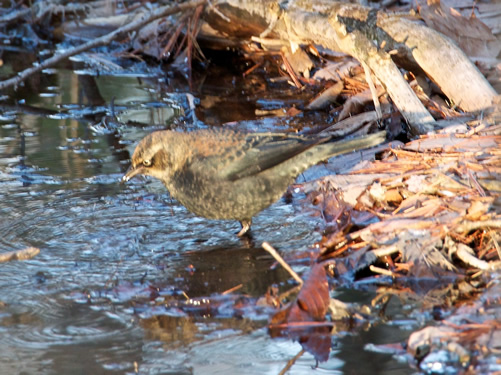
Observer: Paul Lauenstein
Observation Date: 5/6/15
Observation Time: 3:41 p.m.
Observation Location: soccer field parking lot near Gavins Pond
Common Name: Savannah Sparrow
Scientific Name: Passerculus sandwichensis
Comments: Savannah sparrows are often seen in flocks feeding on the ground.
More Information: All About Birds http://www.allaboutbirds.org/guide/Savannah_Sparrow/sounds
Observer: Paul Lauenstein
Observation Date: 7/9/11
Observation Time: 4:50 p.m.
Observation Location: field near Gavins Pond
Common Name: Saw-wing Moth
Scientific Name: Euchlaena serrata
Comments: This specimen alit on my note pad and posed for the photo. Then it flew off. Yet another example of how you don’t find nature. Nature finds you! So keep that camera or smart phone handy!
More Information: BugGuide
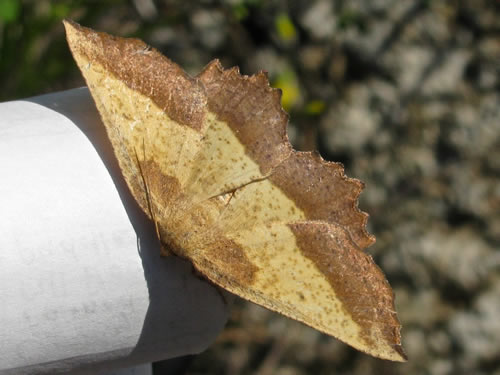
Observer: John Baur
Observation Date: 7/1/11
Observation Time: 2:50 p.m.
Observation Location: Borderland State Park
Common Name: Scarlet Bluet
Scientific Name: Enallagma pictum
Comments: This species is listed as threatened by the Massachusetts Natural Heritage and Endangered Species Program (NHESP).
More Information: MA NHESP
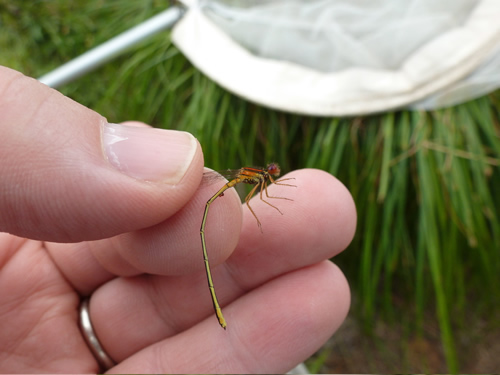
Observer: Paul Lauenstein
Observation Date: 5/15/23
Observation Time: 8:50 a.m.
Observation Location: Moose Hill Audubon Wildlife Sanctuary
Common Name: Scarlet Tanager
Scientific Name: Piranga olivacea
Comments: Scarlet tanagers often play host to eggs of the brown-headed cowbird, particularly where the forest habitat has been fragmented. When a pair of tanagers notices a female cowbird approaching, they aggressively drive her away. If the tanagers don’t notice, the cowbird gets rid of a tanager egg and replaces it with one of her own. The tanagers apparently can’t tell the difference, either before or after the egg hatches, and they raise the imposter along with the rest of their brood.
Scarlet tanagers live in the woods, so the best way to find them is to learn their song and listen for them while walking in the woods. Note that only the male is bright red. The female is drab green.
More Information: All About Birds
Observer: Deb Radovsky
Observation Date: 5/15/23
Observation Time: 4:30 p.m.
Observation Location: Moose Hill Audubon Wildlife Sanctuary
Common Name: Scarlet Tanager
Scientific Name: Piranga olivacea
Comments: Scarlet tanagers often play host to eggs of the brown-headed cowbird, particularly where the forest habitat has been fragmented. When a pair of tanagers notices a female cowbird approaching, they aggressively drive her away. If the tanagers don’t notice, the cowbird gets rid of a tanager egg and replaces it with one of her own. The tanagers apparently can’t tell the difference, either before or after the egg hatches, and they raise the imposter along with the rest of their brood.
Scarlet tanagers live in the woods, so the best way to find them is to learn their song and listen for them while walking in the woods. The Merlin app can be very helpful with this. Note that only the male is bright red. The female is drab green.
More Information: All About Birds
Observer: Paul Lauenstein
Observation Date: 5/16/13
Observation Time: 6:15 a.m.
Observation Location: Moose Hill Audubon Wildlife Sanctuary
Common Name: Scarlet tanager
Scientific Name: Piranga olivacea
Comments: Scarlet tanagers live in the woods, so they are seldom seen due to the foliage. However if you learn their call, which sounds like a robin with a sore throat, you can hear them singing and follow your ears until you find them.
They are often found in pairs. The females are as drab as the males are flashy.
More Information: All About Birds
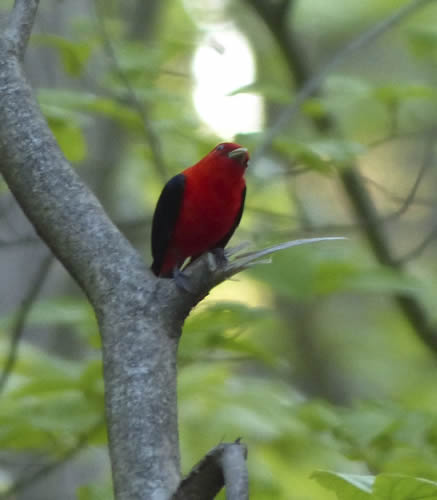
Observer: Paul Lauenstein
Observation Date: 5/16/14
Observation Time: 12:35 p.m.
Observation Location: Moose Hill Audubon Wildlife Sanctuary
Common Name: Scarlet Tanager
Scientific Name: Piranga olivacea
Comments: Scarlet tanagers are common in Sharon, but few people see these brilliantly colored birds because they live in the woods where they are concealed by foliage. If you learn their song, which sounds like a robin with a sore throat, you can find them in wooded areas fairly easily.
More Information: All About Birds
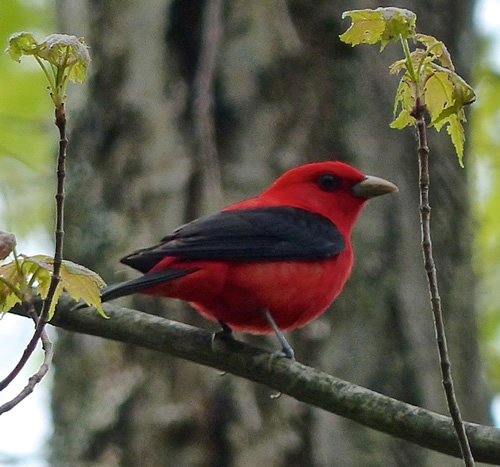
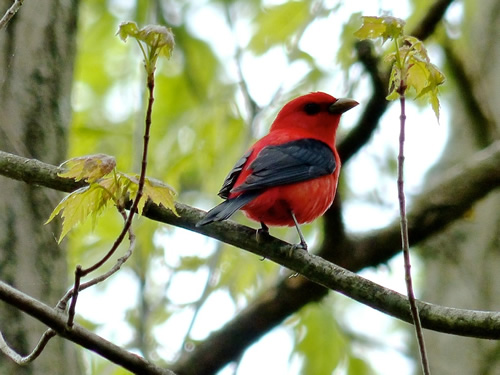
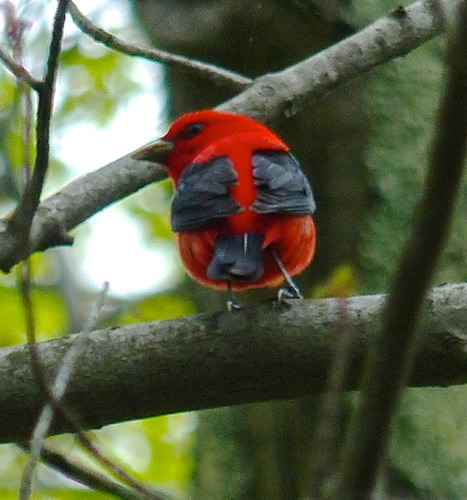
Observer: Paul Lauenstein
Observation Date: 5/23/16
Observation Time: 12:35 p.m.
Observation Location: Moose Hill Audubon Wildlife Sanctuary
Common Name: Scarlet Tanager
Scientific Name: Piranga olivacea
Comments: Scarlet tanagers are common in Sharon, but few people see these brilliantly colored birds because they live in the woods, where they are concealed by foliage. If you learn their song, which sounds like a robin with a sore throat, you can find them in wooded areas fairly easily.
More Information: All About Birds
Observer: Marshall Katler
Observation Date: 5/24/22
Observation Time: 10:15 a.m.
Observation Location: King Phillip Rock where Lakeview Field Trail and Horizon’s path diverge
Common Name: Scarlet Tanager
Scientific Name: Piranga olivacea
Comments: Scarlet tanagers are common in Sharon, but seldom seen. Their woodland habitat obscures them in the leaves. I identified this one by hearing its song. To hear what they sound like, click HERE.
To find them, learn their song and follow your ears as you walk along trails through the woods. Check out the trail maps on this web site.
More Information: All About Birds
Observer: Paul Lauenstein
Observation Date: 5/27/19
Observation Time: 1:10 p.m.
Observation Location: Conservation land near Morse & Lakeview
Common Name: Scarlet Tanager
Scientific Name: Piranga olivacea
Comments: Scarlet tanagers often play host to eggs of the brown-headed cowbird (male and female shown below), particularly where the forest habitat has been fragmented. When a pair of tanagers notices a female cowbird approaching, they aggressively drive her away. If they don’t notice, the cowbird gets rid of a tanager egg and replaces it with one of her own. The tanagers apparently can’t tell the difference, either before or after the egg hatches, and they raise the imposter along with the rest of their brood.
More Information: All About Birds
Observer: Paul Lauenstein
Observation Date: 5/4/23
Observation Time: 7:30 a.m.
Observation Location: Moose Hill Audubon Wildlife Sanctuary
Common Name: Scarlet Tanager
Scientific Name: Piranga olivacea
Comments: Scarlet tanagers often play host to eggs of the brown-headed cowbird, particularly where the forest habitat has been fragmented. When a pair of tanagers notices a female cowbird approaching, they aggressively drive her away. If they don’t notice, the cowbird gets rid of a tanager egg and replaces it with one of her own. The tanagers apparently can’t tell the difference, either before or after the egg hatches, and they raise the imposter along with the rest of their brood.
Scarlet tanagers live in the woods, so the best way to find them is to learn their song and listen for them while walking in the woods. Note that only the male is bright red. The female is drab green.
More Information: All About Birds
Observer: Paul Lauenstein
Observation Date: 5/8/19
Observation Time: 11:10 a.m.
Observation Location: Moose Hill Audubon Wildlife Sanctuary
Common Name: Scarlet Tanager
Scientific Name: Piranga olivacea
Comments: Scarlet tanagers often play host to eggs of the brown-headed cowbird (male and female shown below), particularly where the forest habitat has been fragmented. When a pair of tanagers notices a female cowbird approaching, they aggressively drive her away. If they don’t notice, the cowbird gets rid of a tanager egg and replaces it with one of her own. The tanagers apparently can’t tell the difference, either before or after the egg hatches, and they raise the imposter along with the rest of their brood.
More Information: All About Birds
Observer: Molly DellaRoman
Observation Date: 7/1/13
Observation Time: morning
Observation Location: Trustees of Reservations Moose Hill Farm
Common Name: Scarlet Tanager
Scientific Name: Piranga olivacea
More Information: All About Bird
Observer: Deborah Radovsky
Observation Date: 8/6/20
Observation Time: 7:15 a.m.
Observation Location: Rock Ridge Cemetery
Common Name: Scarlet Tanager
Scientific Name: Piranga olivacea
Comments: Scarlet tanagers are coomon in Sharon, but seldom seen. Their woodland habitat obscures them in the leaves. To find them, learn their song and follow your ears as you wlak along trails through the woods. Check out the trail maps on this web site.
More Information: All About Birds
Observer: Paul Lauenstein
Observation Date: 5/18/23
Observation Time: 9:00 a.m.
Observation Location: Moose Hill Audubon Wildlife Sanctuary
Common Name: Scarlet Tanager (female)
Scientific Name: Piranga olivacea
Comments: Scarlet tanagers are common in Sharon, but few people see these brilliantly colored birds because they live in the woods where they are concealed by foliage. If you learn their song, which sounds like a robin with a sore throat, you can find them in wooded areas fairly easily.
Scarlet tanagers tend to travel in pairs. The males is bright red with jet-black wings. The female is drab greenish yellow with dark wings. I saw this female on the trail gathering nesting materials while the male was singing nearby.
More Information: All About Birds
Observer: Paul Lauenstein
Observation Date: 5/3/18
Observation Time: 10:05 a.m.
Observation Location: Moose Hill Audubon Wildlife Sanctuary
Common Name: Scarlet Tanager (male & female)
Scientific Name: Piranga olivacea
Comments: Scarlet tanagers are common in Sharon, but few people see these brilliantly colored birds because they live in the woods where they are concealed by foliage. If you learn their song, which sounds like a robin with a sore throat, you can find them in wooded areas fairly easily.
Scarlet tanagers tend to travel in pairs. The males is bright red with jet-black wings. The female is drab greenish yellow with gray wings.
More Information: All About Birds
Observer: Deb Radovsky
Observation Date: 5/24/18
Observation Time: 6:15 a.m.
Observation Location: Billings Loop, Moose Hill Audubon Wildlife Sanctuary
Common Name: Scarlet Tanager (male)
Scientific Name: Piranga olivacea
Comments: This scarlet and black woodland bird is common in Sharon but seldom seen because they live in the woods. However, you can find them by learning what their song sounds like.
The female is drab olive-green with dark (but not jet black) wings.
More Information: All About Birds
Observer: Paul Lauenstein
Observation Date: 5/9/19
Observation Time: 6:45 a.m.
Observation Location: Moose Hill Audubon Wildlife Sanctuary
Common Name: Scarlet tanager (orange variant)
Scientific Name: Piranga olivacea
Comments: Male scarlet tanagers are typically bright red with jet black wings (females are drab green). This male, however, was as orange as a Baltimore oriole. Its song was unquestionably that of a scarlet tanager.
More Information: Flickr
Observer: Paul Lauenstein
Observation Date: 5/7/23
Observation Time: 8:45 a.m.
Observation Location: Moose Hill Audubon Wildlife Sanctuary
Common Name: Scarlet Tanager
Scientific Name: Piranga olivacea
Comments: Scarlet tanagers often play host to eggs of the brown-headed cowbird, particularly where the forest habitat has been fragmented. When a pair of tanagers notices a female cowbird approaching, they aggressively drive her away. If they don’t notice, the cowbird gets rid of a tanager egg and replaces it with one of her own. The tanagers apparently can’t tell the difference, either before or after the egg hatches, and they raise the imposter along with the rest of their brood.
Scarlet tanagers live in the woods, so the best way to find them is to learn their song and listen for them while walking in the woods. Note that only the male is bright red. The female is drab green.
More Information: All About Birds
Observer: Paul Lauenstein
Observation Date: 6/2/20
Observation Time: 1:30 p.m.
Observation Location: Near tennis courts at outbound train station
Common Name: Schlaeger’s fruitworm moth
Scientific Name: Antaeotricha schlaegeri
Comments: The Schlaeger’s fruitworm moth is found in north-eastern North America, south to North Carolina and west to Kansas and Texas.
Adults resemble a bird-dropping. The wingspan is 21–30 mm.
The larvae feed on white oak and related species.
More Information: Wikipedia
Observer: Richard Kramer
Observation Date: 6/28/11
Observation Time: 11:59 p.m.
Observation Location: Shores of Lake Massapoag
Common Name: Screech Owl (fledgling)
Scientific Name: Otus asio
Comments: Pair of fledglings were calling and testing their wings.
More Information: Cornell Lab of Ornithology “All About Birds”
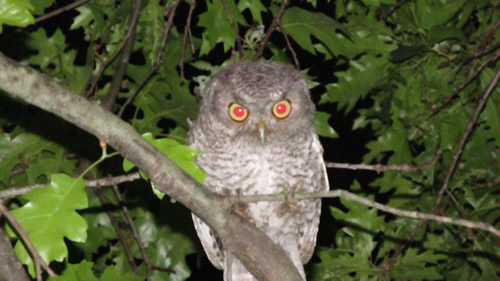
Observer: Paul Lauenstein
Observation Date: 9/18/14
Observation Time: 2:48 p.m.
Observation Place: near Lake Massapoag boat ramp
Common Name: Semipalmated Plover
Scientific Name: Charadrius semipalmatus
Comments: Semipalmated plovers look something like killdeers, but they are smaller and stubbier, and have a single dark band instead of two dark bands like killdeers. Also, killdeers have a red eye ring, whereas semipalmated plovers eyes are black.
More Information: All About Birds
Observer: Josh Simons
Observation Date: 11/20/07
Observation Time: 9:00 a.m.
Observation Location: Moose Hill Parkway
Common Name: Sharp-Shinned Hawk
Scientific Name: Accipiter striatus
Comments: Male is much smaller than the female. The female is about the size and appearance of a Cooper’s hawk. This web page is helpful for distinguishing between these two species of hawks: https://feederwatch.org/learn/tricky-bird-ids/coopers-hawk-and-sharp-shinned-hawk/
More Information: Cornell Lab of Ornithology “All About Birds”

Observer: Josh Simons
Observation Date: 3/28/11
Observation Time: 9:00 a.m.
Observation Location: Moose Hill Parkway
Common Name: Sharp-shinned Hawk
Scientific Name: Accipiter striatus
Comments: Sharp-shinned Hawks are birds of the forest and forest edge, and are not found where trees are scarce or scattered, except on migration. They require dense forest, ideally with a closed canopy, for breeding.
More Information: Cornell Lab of Ornithology “All About Birds”
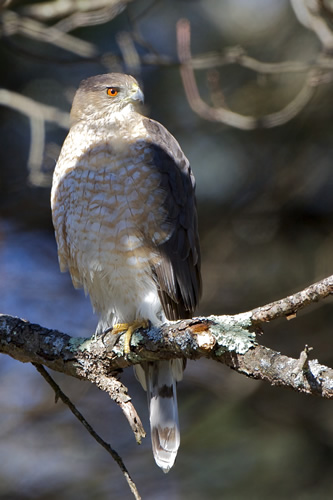
Observer: Michael Bissanti
Observation Date: 3/12/23
Observation Time: morning
Observation Location: Moose Hill St.
Common Name: Short-tailed wWeasel
Scientific Name: Mustela erminea
Comments: White undersides (as opposed to cream-colored), white feet, and small size differentiate short-tailed weasels from long-tailed weasels. Mink are all brown. Short-tailed weasels are also known as a stoats. In winter, they turn all white with a black-tipped tail, and are called ermine.
This weasel tunneled under a chicken wire fence and killed eight chickens before being caught in a Have-A-Heart trap. It was released with permission at a wildlife sanctuary.
More Information: FactZoo
Observer: Paul Lauenstein
Observation Date: 4/16/11
Observation Time: 7:35 p.m.
Observation Location: Gavins Pond Road behind Shaw’s Plaza
Common Name: Short-tailed weasel
Scientific Name: Mustela erminea
Comments: White undersides (as opposed to cream-colored), white feet, and small size differentiate this road-kill specimen from a long-tailed weasel. Mink are all brown. Short-tailed weasel is also known as a stoat. In winter, they turn all white with a black-tipped tail, and are called ermine.
More Information: FactZoo
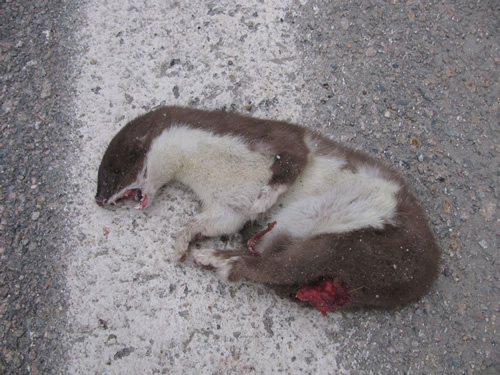
Observer: Paul Lauenstein
Observation Date: 7/13/13
Observation Time: 10:55 a.m.
Observation Location: Gavins Pond area
Common Name: Silver-Spotted Skipper butterfly
Scientific Name: Epargyreus clarus
Comments: Adults perch upside down under leaves at night and on hot or cloudy days.
More Information: Butterflies and Moths of North America
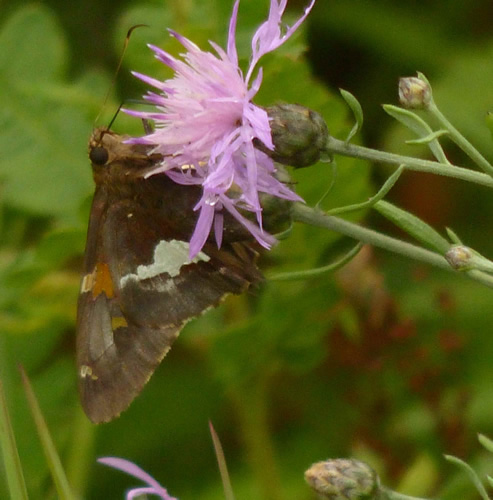
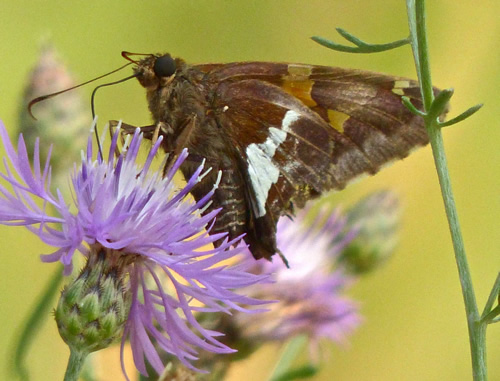
Observer: Paul Lauenstein
Observation Date: 6/2/13
Observation Time: 5:50 p.m.
Observation Place: Gavins Pond Dam
Common Name: Six-spotted Fishing Spider
Scientific Name: Dolomedes triton
Comments: Fishing Spiders get their name from their hunting behavior and occasional food source. They are adept at ambushing insects and other food items on land, but they are also able to submerge their bodies just under the surface of calm water and hunt for small fish and tadpoles. The bristly hairs on their body trap air bubbles that they use to breathe while underwater and waiting for something to swim by. They have been known to stay submerged for more than 30 minutes at a time when hunting in water.
More Information: iNaturalist
Observer: Paul Lauenstein
Observation Date: 5/30/14
Observation Time: 12:10
Observation Location: Power lines near Walpole St.
Common Name: Six-spotted tiger beetle
Scientific Name: Cicindela sexguttata
Comments: Female six-spotted tiger beetles lay eggs in sandy patches. When they hatch, the larvae burrow into the ground. The larvae lie in wait until small arthropods walk by. Then they pounce much like a jack in the box. The larvae pupate after a year. Six-spotted tiger beetles have a total lifespan of about five years.
More Information: Tiger Beetle
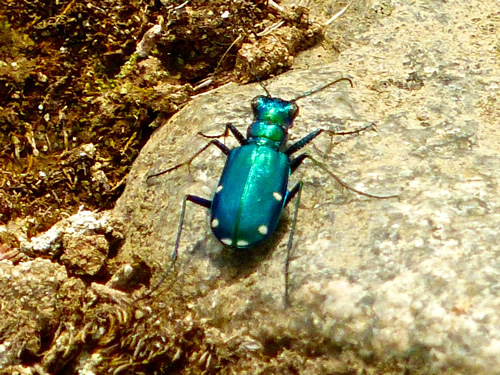
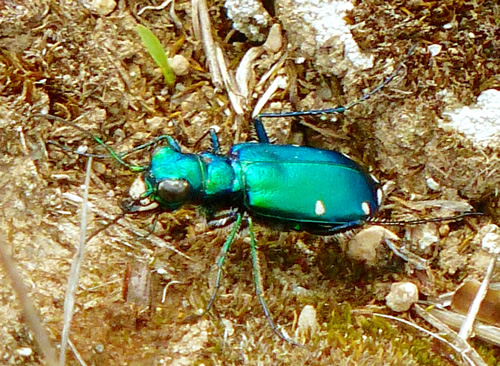
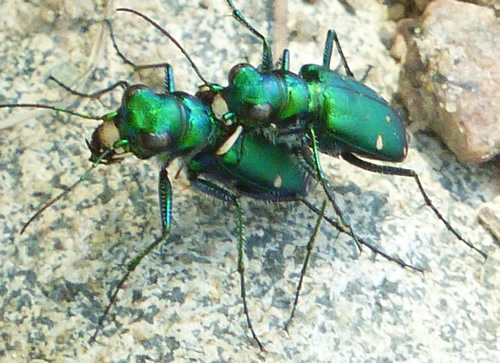
Observer: Paul Lauenstein
Observation Date: 6/2/19
Observation Time: 12:10
Observation Location: beneath the power lines that parallel So. Walpole St.
Common Name: Six-spotted tiger beetle
Scientific Name: Cicindela sexguttata
Comments: Female six-spotted tiger beetles lay eggs in sandy patches. When they hatch, the larvae burrow into the ground. The larvae lie in wait until small arthropods walk by. Then they pounce much like a jack in the box. The larvae pupate after a year. Six-spotted tiger beetles have a total lifespan of about five years.
More Information: Tiger Beetle
Observer: Paul Lauenstein
Observation Date: 6/22/23
Observation Time: 12:45 pm
Observation Location: Gavins Pond
Common Name: Six-spotted tiger beetle
Scientific Name: Cicindela sexguttata
Comments: Female six-spotted tiger beetles lay eggs in sandy patches. When they hatch, the larvae burrow into the ground. The larvae lie in wait until small arthropods walk by. Then they pounce much like a jack in the box. The larvae pupate after a year. Six-spotted tiger beetles have a total lifespan of about five years.
More Information: Tiger Beetle and The Nature Web
Observer: Paul Lauenstein
Observation Date: 6/22/23
Observation Time: 11:00 a.m.
Observation Location: Gavins Pond
Common Name: Slaty Skimmer dragonfly (immature male)
Scientific Name: Libellula incesta
Comments: This is an immature male. Click HERE to learn how to tell the differences among male, female and immature slaty skimmers.
More Information: Odonata.bogfoot.net
Observer: Paul Lauenstein
Observation Date: 6/2/11
Observation Time: 2:50 p.m.
Observation Location: Gavins Pond
Common Name: Slaty Skimmer dragonfly
Scientific Name: Libellula incesta
Comments: The first photo is a female. The second is a male.
Watch this video of the slaty skimmer dragonfly as it oviposits at Gavins Pond.
More Photos: Odonata.bogfoot.net
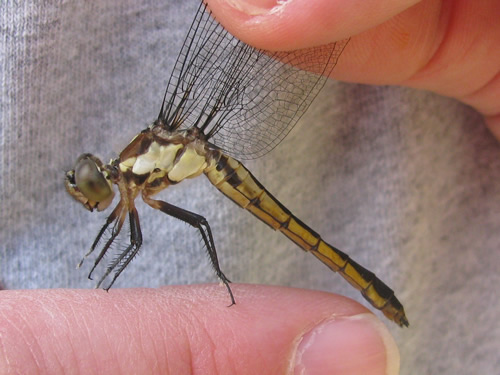
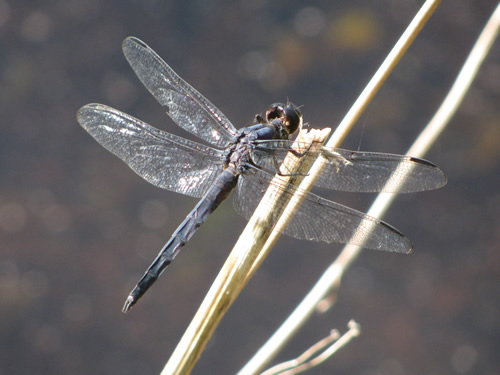
Observer: Josh Simons
Observation Date: 6/14/20
Observation Time: 11:30 a.m.
Observation Location: Moose Hill area
Common Name: Slaty Skimmer dragonfly (female)
Scientific Name: Libellula incesta
Comments: Watch this video of the slaty skimmer dragonfly as it oviposits at Gavins Pond.
More Photos: Odonata.bogfoot.net
Observer: Vin Zollo
Observation Date: 6/15/13
Observation Time: 11:02 a.m.
Observation Location: Moose Hill Audubon Wildlife Sanctuary
Common Name: Slender Spreadwing damselfly
Scientific Name: Lestes rectangularis
Comments: Billings Farm Loop Boardwalk
More Information: BugGuide
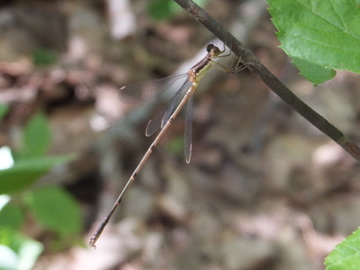
Observer: Paul Lauenstein
Observation Date: 6/25/11
Observation Time: 3:00 p.m.
Observation Location: Gavins Pond near soccer fields
Common Name: Small Cabbage White butterfly
Scientific Name: Pieris rapae
Comments: The top photo shows a copulating pair. The male has a single black wing spot. The female has two black wing spots, and slightly yellower wings.
More Information: Wikipedia
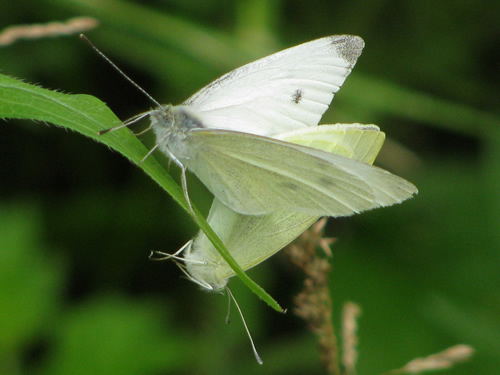
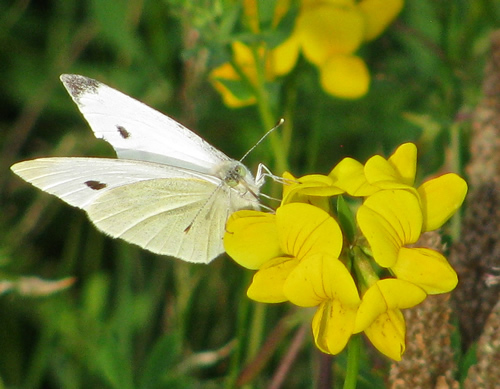
Observer: Paul Lauenstein
Observation Date: 9/7/13
Observation Time: 3:20 p.m.
Observation Location: Gavins Pond Dam
Common Name: Smeared Dagger Moth caterpillar
Scientific Name: Acronicta oblinita
Comments: For pictures of the adult moth, see: http://www.discoverlife.org/mp/20q?search=Acronicta+oblinita&guide=Moth&cl=US/GA/Clarke
More Information: Butterflies and Moths of North America
